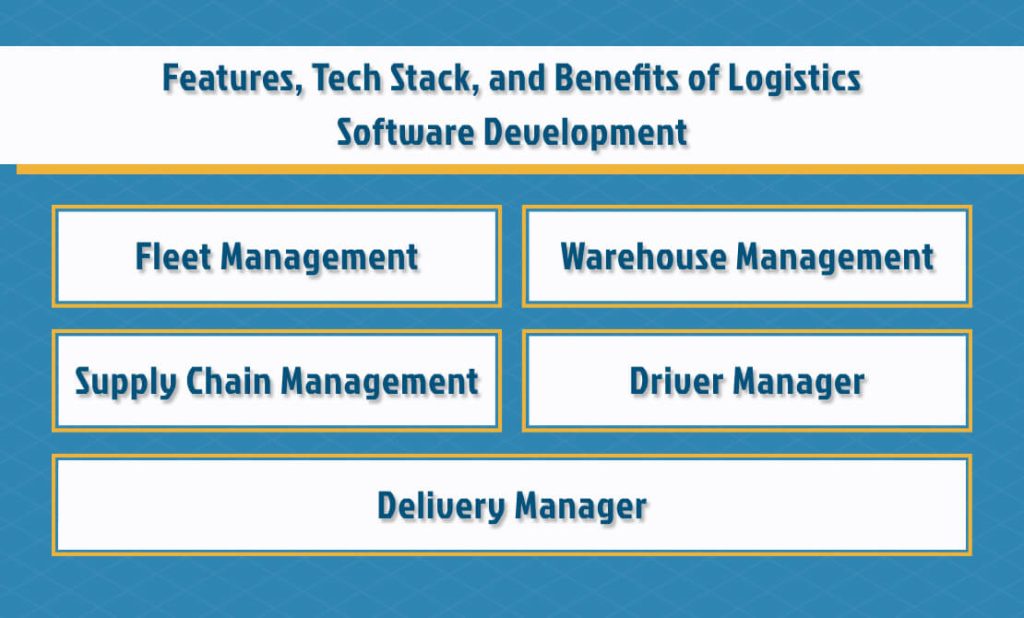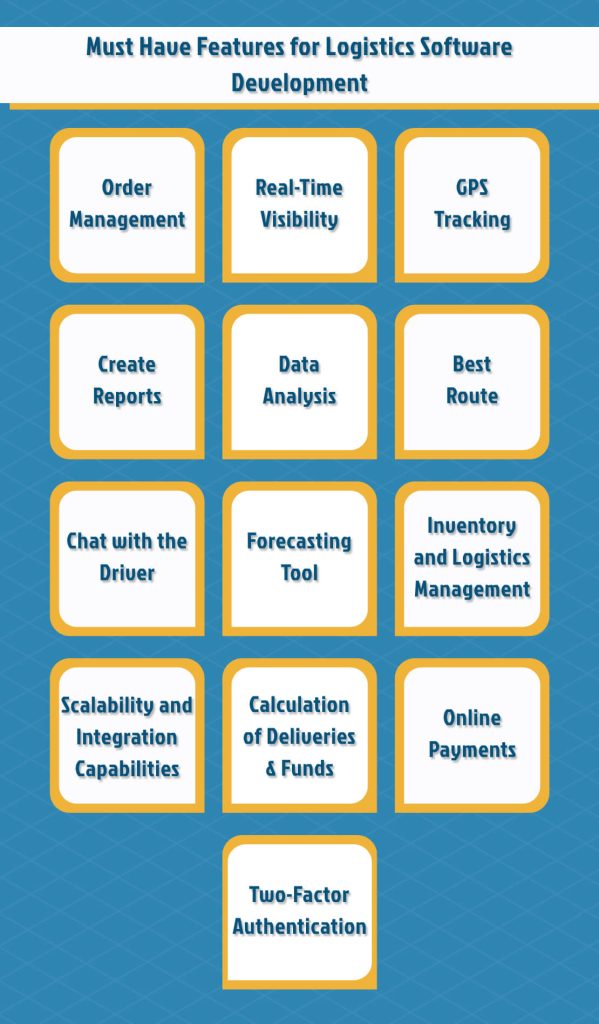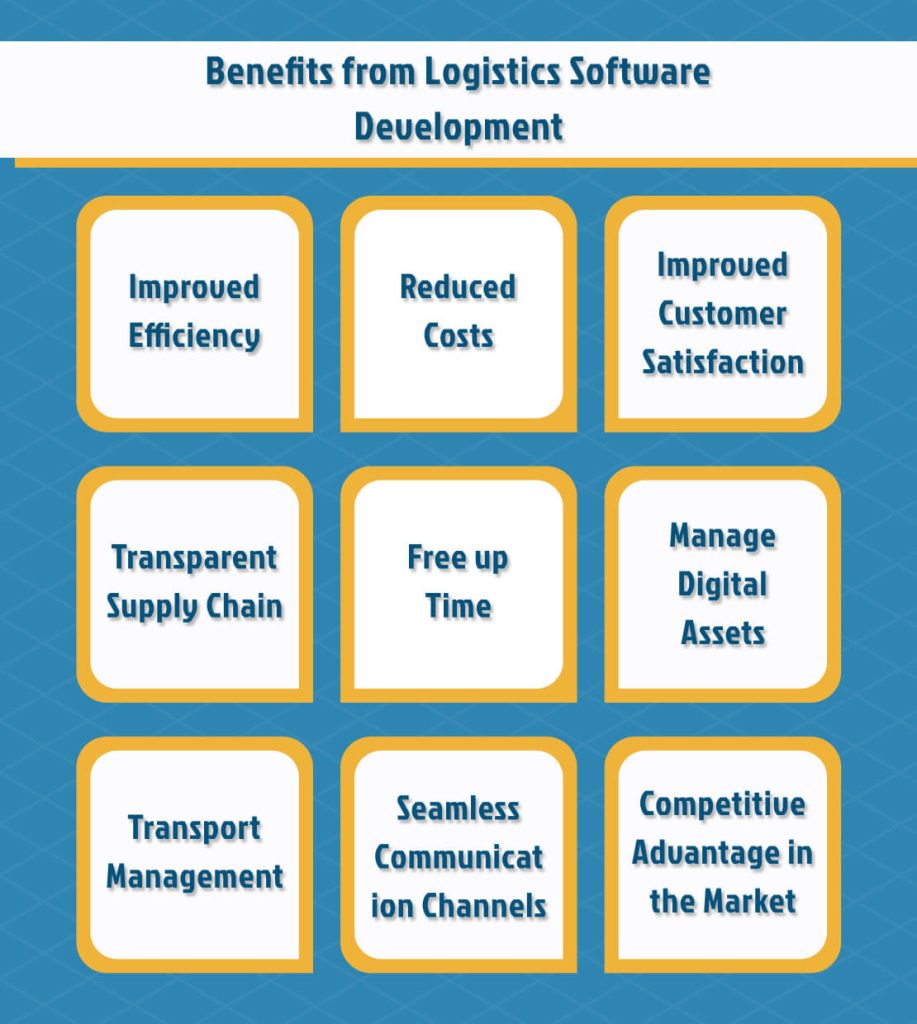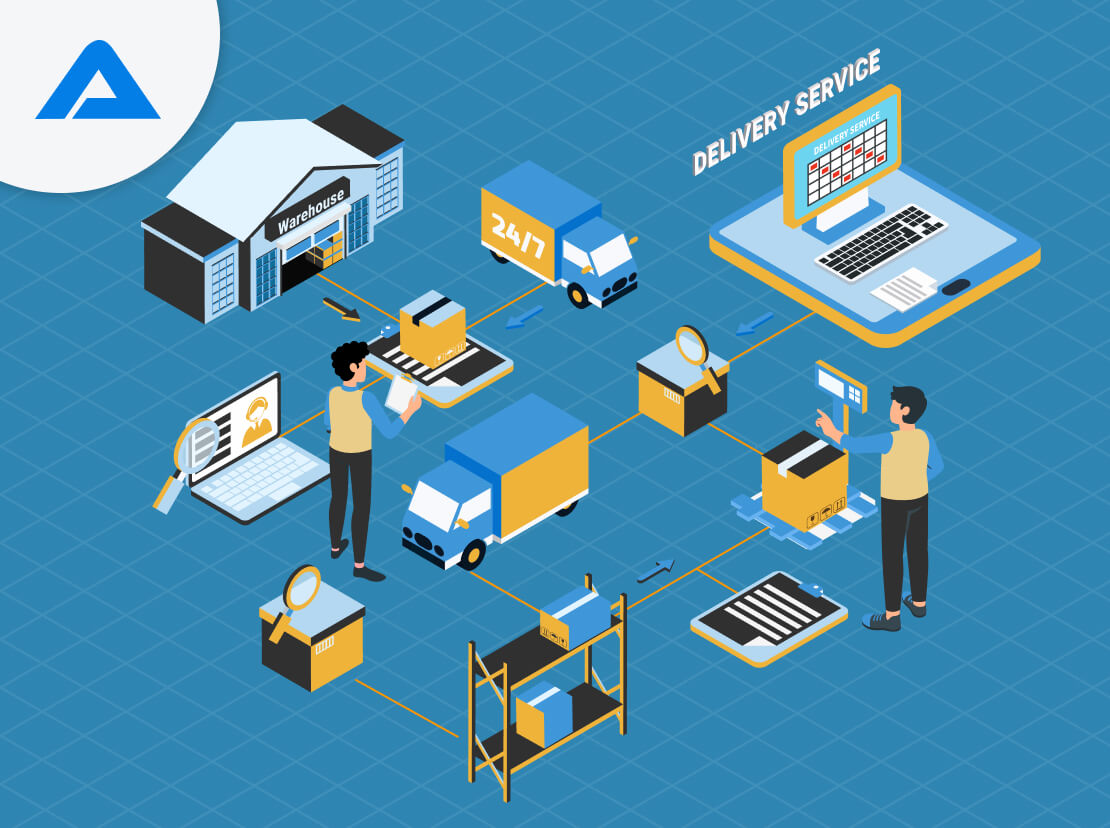Businesses across all industries are looking for ways to improve customer satisfaction and compete in a technologically driven market. How can shipping and transportation companies remain behind in this environment? Like every other company, these companies use modern options to improve operations and overcome core challenges. In this context, the logistics software solutions that are being developed are the most suitable to meet the changing customer demands and technology changes.
It is the best way to automate the complicated shipping and transport processes and enable businesses to streamline their operations.
This guide will explain logistics management software and how it can benefit your business. Learn about the main features and technology stack for logistics software development along with the process.
What Is Logistics Software?
A logistics software platform is a tool for managing logistic operations, such as transportation and inventory management, storage, packaging, and warehouse. The software helps with the overall shipping management and shipping scheduling. It also tracks packages, documents, and other items. Logistics software includes transportation, warehouse and inventory management, route planning, and inventory management.
Software can increase customer satisfaction, engage customers, and retain them. You can foster a lasting relationship with customers by tracking all information in real-time and working on insights. This digital solution allows you to customize your customers’ preferences and enhance their shopping experience. You’ll end up with more customers.
AI can provide detailed analyses of a business’s processes, performance, costs, delays in time, and resource usage. They can also gain valuable insights into manufacturing, delivery, and quality. This allows them to develop effective strategies, lower costs, and provide better services.
Off-the-Shelf Versus Dedicated Logistic Solutions
Logistics companies can use many types of software.
- Warehouse Management Platforms: Tracks a company’s inventory and helps manage distribution operations.
- Enterprise Resource Planning (ERP) systems: Manages everyday activities, such as accounting and purchasing, risk management, and project management.
- Solutions for supply chain management: To evaluate material and human resources, control production and dispatch, and supervise shipments and freightage.
- Transportation Management Systems: Includes shipping logistics software and on-demand logistics apps. These solutions are designed to help you coordinate and execute the movements of goods and ensure that all shipments comply with regulations and are properly documented.
Although each of these solutions is useful for its intended purpose, integrated logistics solutions are better suited to the needs of a business at all levels. Custom software development allows you to combine these features into a single product.
You can also add functionalities to a customized solution that will increase the efficiency of your staff. Our team, for example, integrated offline maps into Atlas, an application designed for truck drivers. These features allowed truck drivers to plan and verify routes anywhere, including in remote Kazakhstan regions with no network coverage.
Types of Logistics Software

The area of application for logistics varies.
Fleet Management
You can manage your transportation data more efficiently and quickly with fleet management applications. These apps also help companies optimize fleet processes to ensure that all work is completed efficiently. Fleet management apps provide all the information you need at your fingertips. They are easy to use and understand for everyone.
Warehouse Management
A data warehouse management app helps you organize and track your items in the warehouse. It streamlines the entire process and makes warehouse management easier and more efficient.
Supply Chain Management
Supply chain app developers develop special apps to help businesses keep track of inventory and how things are done. These apps also help identify any problems in the supply chain process by tracking workflows. It also boosts efficiency in the business.
Driver Manager
These apps manage drivers’ data to ensure that logistics are efficient. They also meet their needs. You can use driver management apps to track a driver’s position, keep an eye on their stock, and manage their profile.
Delivery Manager
Deliver management apps can help companies manage their delivery operations. They also provide features such as tracking packages, assigning drivers, optimizing routes, and updating customers on delivery status. These apps streamline and manage the delivery process to customers.
Must Have Features for Logistics Software Development

Several essential features in logistics software can improve efficiency and streamline operations. We will now look at some of the most important features you should look for.
Order Management
This feature allows you to create, update, and manage orders efficiently. You can also track their status and generate the relevant documentation, such as invoices and shipping labels. This feature streamlines operations improves accuracy, and increases customer satisfaction.
Real-Time Visibility
It is impossible to overstate the importance of real-time transparency across all aspects of the custom supply chain software. The convenience of being able to track their orders and receive updates about delivery in real-time is highly valued by customers. As visibility and tracking have increased, 31% of companies consider this essential to keep their promises to clients.
Dispatchers also need tools to adapt quickly to sudden changes, such as last-minute cancellations or orders. They can make these decisions immediately if they have the data at hand. Things will inevitably change, so it is essential to have an overview of your entire supply chain to allow your agents and dispatchers to respond quickly to unexpected obstacles.
GPS Tracking
GPS tracking is necessary, so you and your client can track the shipment in real-time. This is useful because it keeps you and your customers informed of the location of their shipment, the expected arrival time, etc.
Create Reports
You can increase productivity by including document and report generation features in your software. All contracts and agreements, for example, will be collected in one place, making it easy to filter out the relevant ones. The reports will help you get up-to-date information such as recent profits and shipments over the past six months.
Data Analysis
You can make better decisions with predictive data analytics. Many businesses are now prioritizing the use of data analytics and strong data in the development of their logistics software. The function forecasts demand based on previous shopping patterns, preferences, orders, and purchasing behavior. It is easier to understand the future potential for improvement and make better decisions.
Best Route
The logistics app’s best route feature helps optimize delivery by finding the most efficient way to transport goods. It considers distance, traffic, and delivery time to ensure drivers take the fastest and smoothest route, saving them time and money.
Chat with the Driver
Messages and calls can be used to communicate between drivers, shippers, and managers.
Logistics managers can alter routes in the event of an accident or breakdown. The driver can give the customer the necessary delivery information.
Forecasting Tool
Forecasting is essential to stay ahead of your competition. The system is designed to work as efficiently as possible to anticipate consumer needs and plan logistics. This tool will help you reduce costs by ensuring the correct amount of raw materials is purchased and stored.
Inventory and Logistics Management
You can easily manage and track inventory levels, warehouse operations, and logistics processes. Inventory management software lets you quickly follow stock levels, plan replenishment, track shipments, and optimize storage. The task of managing and optimizing inventory is one of the most difficult. Tagging the inventory using barcodes and QR systems can be a great way to track damaged or missing items.
Scalability and Integration Capabilities
It’s like sailing without a map to run dynamic supply chain operations. It is more than just a tool. It connects to other business systems, such as Enterprise Resource Planning (ERP) and procurement management software. This allows them to work in harmony, optimizing processes. It makes everything easier, from sourcing the raw materials to managing the production of finished goods and delivering them.
The scalability of Learning Management System (LMS) allows you to adapt and grow as your business changes. LMS’s end-to-end automated processes across your entire logistics system will help you create a supply chain that is highly efficient and flexible.
Calculation of Deliveries & Funds
Evaluating shipping costs clearly and carefully is essential to keep your business healthy. You should avoid shipping rates that are excessively high or too low, and you will risk losing clients. This function lets your customers quickly calculate how much they will have to pay for shipping.
Online Payments
You can offer online payment to your customers. Your customers can, for example, pay online while in traffic or even at home. This will speed up the delivery.
Two-Factor Authentication
If you want to protect your software, two-factor authentication is a must. This functionality allows only users who have completed two rounds of identification verification to access the system. Your login information will remain private.
Quick Steps to Develop Logistics Software
You will need to plan carefully if you are planning on customizing your logistics management software. Therefore, choosing the best company for custom logistics software development is essential. Your team’s expertise will play a significant role in each development phase. These steps will be an integral part of the development process.
Define Your Goals
The first step in developing software for logistics management is to define your goals. Once you have clearly defined your goals, planning is the next step in the process. When evaluating your goals, it is essential to consider these factors:
- What can you expect from the software?
- What segment of logistics do you plan to use this software for?
- Why would you need custom logistics software?
What features and functions will you need to include to achieve success with your project?
These questions can help you to understand your idea. It will also allow you to estimate development costs.
Select the Deployment Type
The second step of logistics software development involves deciding on a deployment plan. All services are installed on your company’s hardware and servers in an on-premises implementation. Your company will have full control of the management and maintenance of your software. This deployment method is more expensive and less flexible but offers better security. It also gives your company full control over servers and backups.
Cloud-based software resides offsite and is monitored and maintained by another company. It is cheaper to use cloud-based software because you do not need to purchase extra hardware or hire an internal team to upgrade and maintain the system. A cloud-based system can also be integrated with previous systems. Cloud solutions are also very convenient because users can access them from anywhere.
Select Features
You will choose the features for your software based on what type of software you plan to develop. The features you need in your software plan will depend on whether you are developing warehouse or transportation management software.
Among the features common to all logistics software are real-time tracking and inventory management. There’s also route planning, optimization, analytics, and reporting. The functionalities will be adapted to your project’s goals. You must, therefore, consider these points before concluding.
Hire the Right People
Finding the right people for your project is important because your company’s future success will depend on it. You should seek out those with industry experience to get the best expertise for the logistics software development project.
Software Development Process
The first step is to decide if you want your solution to be cloud-based or on-premises. Does your program require a mobile-friendly version? Keep in touch with the development team and attend your scheduled sessions online to stay on track and measure your progress.
Quality Assurance
Hire QA engineers should be part of the development process, in which QA professionals evaluate performance and functionality. You can take part in the second round of software testing as a product owner to evaluate the robustness of the logistics management solution.
Product Deployment and Scaling Up
It’s time to train your team to use your new logistics management software. Your team will be able to provide valuable feedback at this stage. You can ask the developers to upgrade or add new functionality to your solution when you decide to change or scale up your business.
Benefits from Logistics Software Development

Here is how you can use the services now that you better grasp logistics and supply-chain software development.
Improved Efficiency
Logistics and supply chain organizations require energy, resources, and a workforce to run efficiently. Software development services can help companies automate processes and increase efficiency. It means less manual work, which allows business owners to focus on strategic decisions and customer service. If you want to track a shipment’s progress, you could create an app that gives you real-time updates. Your employees will be able to ensure the shipment’s arrival on time with this information.
Reduced Costs
The upfront costs of developing a custom app can be high. The long-term benefits of using software development services for logistics and supply chains can be priceless. Automating processes, for example, can reduce costs by reducing human resources and labor. The software also helps you save in other areas, such as customer service and inventory tracking.
Improved Customer Satisfaction
Customers are essential in today’s online world. This includes companies that deliver products. Your mobile app will make customers happy because it offers more than expected. Think of your app as a link between your delivery service and customers. It allows them to see and manage their orders in real-time. This level of transparency with your customers will build trust, which is just as important as what you send.
Customers will be amazed at how a logistics app can transform their experience. Instead of wondering where their order is, customers can track it. With a single tap, they can get updates, tell you when something goes wrong, or even change the location of something. This powerful communication empowers the customer, encouraging a sense of security and loyalty.
Transparent Supply Chain
In the past, customers would book shipments and then wait to hear from a representative by phone. Modern software allows customers to see the status of their orders and track them whenever they like. With tracking software, companies can keep track of their internal and external operations, ensuring they meet their goals and establish transparent relationships with chain participants.
Free up Time
The software can automate many logistics processes. You can now manage the logistics side of your business with less human involvement. Billing and inventory, for example, are now more automated. This is a benefit for two main reasons. It reduces the possibility of human error. The team can then focus on higher-level tasks.
Manage Digital Assets
Software for logistics can assist you in managing data and documents. The software can extract data from different sources and run it through different components to reach valuable conclusions. Documents such as invoices can be stored. All the information is in one location, making it easier to work and saving you time.
Transport Management
The logistics software platform is used to manage the transportation of goods between points of dispersal and consumption. It helps businesses plan, execute, and optimize physical goods movements. It ensures that all documentation and compliance are in place for the shipment.
Competitive Advantage in the Market
It’s like upgrading your old tool to a new one. It helps your business to stand out. It’s about being the only one people notice in an area where many delivery companies try to gain attention and retain their customers. An app will show your customers that you are following the latest trends and leading them.
Apps are a great way to try new things to make you stand out. It could be a way to determine the best delivery routes or an app feature that can predict delays. Modern solutions can be more than just a show. Apps aren’t just a nice extra, they signal that your business is prepared for the future. Preparing for the future could be a massive plus in a game where tomorrow’s stuff happens today.
Seamless Communication Channels
Talking to one another can make or break you in sending things from place to place. Mobile apps let you soar above the chaos. These apps aren’t just tools; they’re your lifeline to communicate with everyone in your company, from the people who pack boxes in the warehouse to the driver delivering packages and the customers waiting for their items.
The mobile app that moves goods makes it easier to communicate. It also keeps the conversation up-to-date. Problems that took much time to solve can be resolved quickly. No one is interested in the missed calls or emails of old. With alerts that appear instantly, chat, and updates that are sent in as they happen, everyone is aware.
The smooth communication between the parties creates a clear picture for all. Imagine that a driver can tell the base about a jam on a narrow road. A boss can alter the delivery route with a simple tap. And customers can track their orders at every stage. It’s not just about chatting but keeping everyone informed, updated, and part of the action.
Tech Stack for Developing Logistics Software
Each type of logistics software development services requires a specific tech stack. It is essential to understand your business processes, target market, and the tasks you need to automate and monitor to choose the best tech stack.
The tech stack you choose will affect scalability and expansion costs. It can also impact the integration of other apps with your business.
Back End Software Development
How do you develop server-side logistics software? Back-end development mainly involves PHP, Python C#, C++, Java, and JavaScript. Frameworks used for back-end programming include.NET (for C#), Spring, Hibernate, Struts or CherryPy (for Java); Django Flask Hug Bottle or CherryPy; Laravel CakePHP CodeIgniter or Symfony (for PHP); or Django Flask and.NET in C#.
The framework chosen will depend on the type of application, its features, and the platform. Platform-specific programming languages and frameworks are also used to develop mobile apps. For iOS, Swift or Objective C are used for app development. Java or Kotlin is used for Android.
Front End Software Development
How do you develop the front end of software for logistics management? The front end of the application combines HTMS with CSS and JavaScript. The application’s Visual components will be created using these languages in conjunction with frameworks such as React, Angular.js, or Vue.js.
Additional Frameworks
When interacting with shipping APIs, logistics software requires a framework capable of handling data requests from multiple data sources. GraphQL and REST APIs are useful when working with data from the front end to the back end. Additional frameworks will also be used to handle future integrations and payment processes.
Consult an experienced company that develops logistics software if you still need to determine which technologies are best for your business. AddWeb Solution can provide options and explain why one technology is better.
The Key Takeaway
Businesses should rely on up-to-date software to adapt to the changing market. As the delivery volume and customer expectations increase, they must adapt. Implementing software for logistics management is a great way to streamline operations, reduce costs, and optimize storage, transportation, and staffing.
AddWeb Solution, a logistics software development company specializing in logistics management, has a wealth of domain knowledge and experience. We can help you create a serverless, GDPR-compliant logistics solution that integrates seamlessly with your existing software. Contact our experts to build exceptional software for your business.
